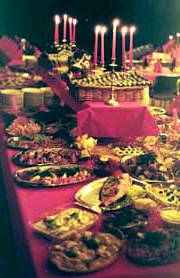The traditions of Christmas in America have their roots in many lands, a reflection perhaps of the many nationalities and cultures that make up our nation of immigrants. In this blog we will take a look at the traditions emanating from Scandinavia and Spain.
 In Sweden, pagan customs mingled with Christian ritual. In heathen times, it was believed that at Christmas the dead returned to earth, so food and drink were set out for them. Today, children set out food for Santa Claus.
In Sweden, pagan customs mingled with Christian ritual. In heathen times, it was believed that at Christmas the dead returned to earth, so food and drink were set out for them. Today, children set out food for Santa Claus.
In villages throughout Sweden young girls vie each year for the honor of portraying Saint Lucia on Dec. 13. On that day, a young girl clad in white with a crown of candles on her hair is followed by other young people carrying burning candles as sleeping families are awakened at dawn with an offering of wheat cakes and coffee.
Of course, the famous Scandinavian smorgasbord of cheeses, breads, salads and meats is replicated at holiday open houses and gatherings throughout America each Christmas season.
After weeks of Christmas preparations, homes in Finland are ready for holiday celebrations by noon on Christmas Day. A straw framework, decorated with paper stars suggestive of heaven, is suspended from the ceiling. Lighted from below by the glow of firelight and the Christmas tree, the framework produces a mysterious effect. Straw is heaped on the floor and, like the Christ Child, the children sleep on this manger-like bed.
In honor of Christmas Eve celebrations, each member of the Finnish family takes a traditional sauna or steam bath. After the sauna, all gather about the table while the head of the family solemnly reads the Christmas prayer and sermon. Little children visit other homes during the evening, but return early to see if the man dressed as a yule goat, Father Christmas, has left any presents for them.
Throughout Spain, Christmas is a time of devout religious ceremony that begins on the Feast of the Immaculate Conception on Dec. 8. Before midnight Mass on Christmas, little Spanish children dress in peasant costumes and enact an age-old Christmas Eve tradition of dancing around the Nativity scene to the musical accompaniment of tambourines.
The Christmas observance ends with the children receiving their gifts on Jan. 6. The gifts are said to be left by the Magi passing through on their way to Bethlehem. In the big cities, elaborate parades are held honoring the Three Kings.
Spanish children have no Christmas tree and do not hang up their stockings on Christmas Eve. Instead they hide slippers and shoes for Balthasar and the Wise Men to fill with goodies.